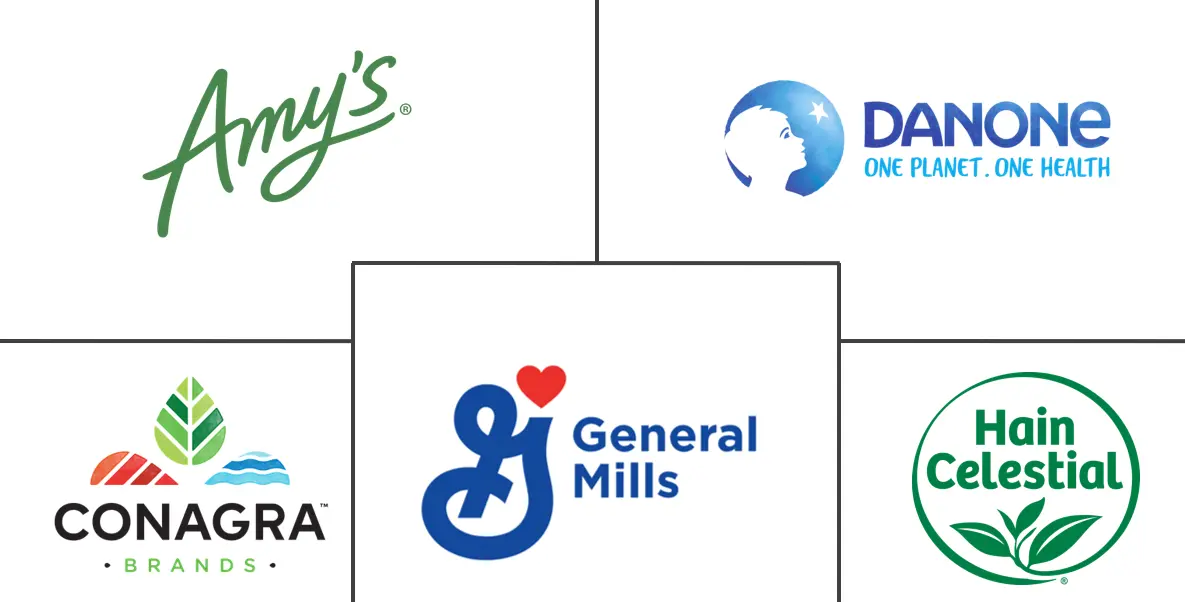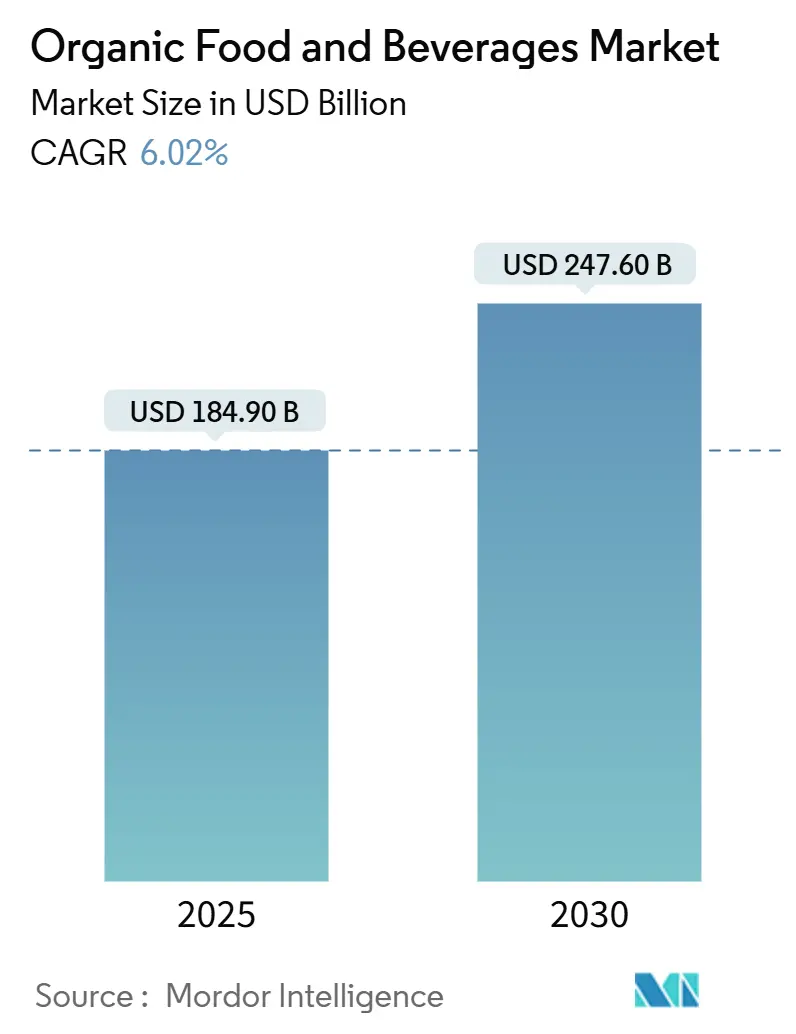
Organic Food And Beverages Market Analysis by Mordor Intelligence
The organic food and beverages market, valued at USD 184.9 billion in 2025, is projected to reach USD 247.6 billion by 2030, growing at a CAGR of 6.02%. The global organic food and beverage market is witnessing robust growth, fueled by rising health consciousness, sustainability concerns, and a demand for convenience. Consumers are actively choosing organic products to reduce their exposure to synthetic additives and pesticides, particularly in staple categories like organic fruits, vegetables, dairy, and plant-based alternatives. Governments, including the European Union, are focusing on organic farming initiatives, aiming to convert a significant share of farmland to organic by 2030. As a result, consumers increasingly favor products that reflect sustainability and ethical farming. This trend is especially pronounced in the beverage sector, where demand for organic teas, juices, and functional drinks is rising. These options appeal not only to health-focused buyers but also to those preferring natural, minimally processed alternatives. Online platforms further support this shift by offering broader product ranges, transparent sourcing, and grocery delivery features that resonate strongly with digitally savvy, urban consumers. Technological advancements in the supply chain are also enhancing consumer trust. Tools like AI-driven cold-chain logistics and blockchain traceability ensure product freshness, authenticity, and reduced waste. These innovations directly address concerns about food safety and fraud, particularly in high-risk perishable categories. Reflecting today’s fast-paced lifestyles, there is also growing demand for ready-to-eat and easy-to-prepare organic products. This has led to a surge in organic meal kits, snacks, and beverages that blend health benefits with everyday convenience.
Key Report Takeaways
- By product type, organic foods led with 86.6% of the organic food and beverages market share in 2024; organic beverages are projected to grow at a 7.26% CAGR to 2030.
- By form, fresh and chilled products accounted for a 62.4% share of the organic food and beverages market size in 2024, while frozen organic items are advancing at a 7.55% CAGR through 2030.
- By distribution channel, supermarkets and hypermarkets held 56.8% revenue share in 2024; online stores record the fastest CAGR at 8.43% to 2030.
- By geography, North America commanded 43.1% of the organic food and beverages market in 2024; Asia-Pacific is the fastest-expanding region with a 7.46% CAGR to 2030.
Global Organic Food And Beverages Market Trends and Insights
Drivers Impact Analysis
| Driver | (~) % Impact on CAGR Forecast | Geographic Relevance | Impact Timeline |
|---|---|---|---|
| Rising health consciousness and lifestyle disorders | +1.2% | Global, with concentration in North America and Europe | Long term (≥ 4 years) |
| Government support and subsidies for organic farming | +0.8% | North America, Europe, with emerging support in Asia-Pacific | Medium term (2-4 years) |
| Growth of e-commerce and organic delivery platforms | +1.0% | Global, led by North America and Asia-Pacific urban centers | Short term (≤ 2 years) |
| Clean label and ingredient transparency trends | +0.7% | North America and Europe core, spillover to Asia-Pacific | Medium term (2-4 years) |
| Increased availability of organic offerings | +0.6% | Global, with rapid expansion in emerging markets | Long term (≥ 4 years) |
| Premiumization and urban affluence | +0.9% | Urban centers globally, concentrated in developed markets | Long term (≥ 4 years) |
| Source: Mordor Intelligence | |||
Rising Health Consciousness and Lifestyle Disorders
The organic food market continues to grow as consumers become more health-conscious and aware of lifestyle-related health conditions such as obesity, diabetes, and cardiovascular diseases. The direct correlation between diet and health outcomes has prompted consumers to prioritize organic food products in their purchasing decisions. Millennials and Generation Z are significant drivers of market growth, showing strong preferences for organic and sustainable food options. According to the Organic Trade Association, 90% of Generation Z consumers (ages 13-28) identify as committed or new organic consumers.[1]Source: Organic Trade Association, “2024 U.S. Organic Industry Survey,” ota.com The market is expected to maintain its growth trajectory as these demographics advance professionally and start families. These younger consumers demonstrate a willingness to pay higher prices for organic products, primarily due to perceived health benefits, including higher nutrient content and reduced pesticide exposure. Market expansion is also supported by growing concerns about conventional farming methods, such as the use of synthetic pesticides and genetically modified organisms, along with improved organic product availability across retail channels, including supermarkets, specialty stores, and online platforms.
Government Support and Subsidies for Organic Farming
Government support and subsidies are playing a pivotal role in accelerating the adoption of organic farming, making it more accessible and economically viable for producers through financial aid, certification assistance, and capacity building. In France, the Ministry of Agriculture and Food Sovereignty rolled out a EUR 90 million aid scheme in February 2024 to bolster organic farms in economic distress, adding to a prior EUR 104 million allocation in 2023 [2]Source: Ministry of Agriculture and Food Sovereignty, "Organic Farming Support Scheme 2024: €15 million increase in the budget envelope to support organic farms that have suffered economic losses", agriculture.gouv.fr. In the U.S., the USDA’s Organic Transition Initiative earmarked USD 300 million to assist farmers in transitioning to organic practices, complemented by an additional USD 20 million from the Organic and Transitional Education and Certification Program to alleviate certification costs[3]Source: U.S. Department of Agriculture, “Organic Transition Initiative Fact Sheet,” usda.gov. At the EU level, the Farm to Fork strategy, part of the European Green Deal, targets having 25% of agricultural land under organic cultivation by 2030. This ambition is backed by a detailed Organic Action Plan featuring 23 measures aimed at boosting demand, aiding farmer transitions, and promoting environmental sustainability [4]Source: European Commission, “EU Organic Action Plan,” ec.europa.eu.In India, the government champions organic farming through initiatives like the Paramparagat Krishi Vikas Yojana (PKVY) and the Mission Organic Value Chain Development for North Eastern Region (MOVCDNER). These programs provide comprehensive support, from training and certification to post-harvest management and marketing. Collectively, these initiatives underscore a strategic alignment between policy and consumer demand, ensuring the organic sector's growth is both principled and empowering for farmers embracing sustainable practices.
Growth of E-commerce and Organic Delivery Platforms
E-commerce and quick-commerce platforms are rapidly boosting the organic food and beverage market by making products more accessible and visible. These platforms provide consumers with the convenience of purchasing a wide range of organic items, including fresh produce, dairy, meat, frozen meals, and beverages like organic juices, teas, and coffee. The ability to cater to smaller basket sizes and offer faster delivery has made these platforms highly appealing to modern consumers. For instance, U.S.-based Instacart features a dedicated "Organic Grocery" section on its website and app, enabling users to easily filter and differentiate organic products from conventional ones. This categorization not only simplifies the shopping experience but also enhances the visibility of organic brands, encouraging more consumers to explore and adopt organic options. Additionally, e-commerce algorithms significantly contribute to consumer engagement by providing personalized recommendations based on browsing and purchase history, as well as targeted promotions that align with individual preferences. These features help organic brands connect with their target audience more effectively, driving sales and fostering brand loyalty.
Clean Label and Ingredient Transparency Trends
As consumers increasingly demand ingredient transparency, the organic food and beverage retail landscape is transforming. Shoppers are now more attuned to food seasonality, sourcing, and the visibility of the supply chain. This heightened awareness is especially pronounced in fresh categories, including organic fruits, vegetables, meats, and dairy, where consumers prioritize understanding production practices and origins. In response, retailers are sharpening their focus on fresh food strategies, amplifying merchandising efforts, and weaving compelling narratives around their organic selections to foster engagement and trust. Regulatory frameworks, like the U.S. Food Safety Modernization Act, bolster this movement by mandating enhanced traceability. This requirement dovetails seamlessly with the documentation practices of organic producers, who meticulously detail inputs, production methods, and handling throughout the supply chain. Blockchain technology is playing a pivotal role in amplifying supply chain transparency. A case in point is the EU’s TRICK project, which, buoyed by an investment of USD 8 million, is harnessing blockchain platforms to bolster data integrity and traceability for organic products, streamlining customs processes and compliance checks.
Restraints Impact Analysis
| Restraint | (~) % Impact on CAGR Forecast | Geographic Relevance | Impact Timeline |
|---|---|---|---|
| High price compared to conventional food | -1.8% | Global, most pronounced in emerging markets | Short term (≤ 2 years) |
| Inconsistent quality and lack of standardization globally | -0.9% | Global, particularly affecting international trade | Medium term (2-4 years) |
| Complex certification and compliance processes | -0.7% | Global, with highest impact on small producers in developing regions | Medium term (2-4 years) |
| Limited cold chain in emerging economies | -0.5% | Asia-Pacific, South America, Africa, with spillover to export markets | Long term (≥ 4 years) |
| Source: Mordor Intelligence | |||
High Price Compared to Conventional Food
High prices remain a significant hurdle for the widespread adoption of organic food and beverages, especially as inflation pushes overall food costs higher. In developing regions like Africa and Asia-Pacific, consumers grapple with rising living expenses and a limited selection of affordable organic options. This challenge makes it tough for them to prioritize long-term health benefits over immediate cost savings. Even in urban areas, where organic products are more accessible, a notable price premium often stemming from supply chain inefficiencies, certification costs, and restricted local production deters broader adoption across various income groups. Additionally, limited local production in many regions forces reliance on imports, which are subject to tariffs, currency fluctuations, and other trade-related expenses, further inflating prices. Addressing these challenges requires a multi-faceted approach, including improving supply chain efficiency, increasing local organic production, offering more affordable product tiers, and implementing consistent government and retail support to make organic products accessible to a wider audience.
Inconsistent Quality and Lack of Standardization Globally
U.S. and EU organic regulations are out of sync, leading to significant certification hurdles that affect product availability, pricing, and consumer trust, especially for imports like organic meat, dairy, and processed foods. The USDA's Strengthening Organic Enforcement rule, implemented to enhance the integrity of organic products, mandates import certificates and stricter traceability measures to ensure compliance with U.S. standards. In contrast, the EU operates under Regulation (EU) 2018/848, which provides a comprehensive framework covering production methods, labeling requirements, control systems, and the use of approved substances. These divergent regulatory standards create a scenario where a product certified organic in the U.S. might require re-certification to meet EU standards, and vice versa, adding operational complexity and costs for multinational producers. The situation is particularly challenging for small producers in developing nations, who often lack the resources to meet the EU's stringent group certification criteria. This limits their participation in global trade, reducing the diversity of ethically sourced organic products available in international markets. These regulatory inconsistencies and certification gaps influence consumer perceptions of authenticity and trust in organic labels. Addressing these challenges requires greater collaboration between regulatory bodies to streamline certification processes and create a more unified global organic standard, which could benefit producers, consumers, and the organic market as a whole.
Segment Analysis
By Product Type: Beverages Drive Innovation Despite Foods Dominance
In 2024, organic foods commanded a significant 86.6% share of the total market revenue, with fruits and vegetables at the forefront. This stronghold is largely attributed to heightened consumer awareness regarding pesticide-free produce and an increasing inclination towards sustainable farming. Additionally, meat, fish, and poultry are witnessing a surge, as consumers draw connections between premium protein sources and their health and environmental advantages. On another front, the demand for frozen and processed organic foods is on the rise, bolstered by advancements in cold chain infrastructure, extended shelf life, and a growing appetite for convenient yet nutritious meals. Furthermore, regulatory shifts, highlighted by the USDA's introduction of organic standards for mushrooms in February 2025, are paving the way for market growth, particularly benefiting small-scale producers and niche manufacturers.
Organic beverages are emerging as the segment with the most rapid expansion, forecasted to grow at a 7.26% CAGR, surpassing the overall market pace. This surge is driven by a rising consumer appetite for clean-label, functional, and plant-centric beverages. Brands are honing in on health-focused urbanites, employing premium packaging and emphasizing nootropic advantages. Their diverse offerings span from organic kombucha (like Health-Ade) and probiotic shots (such as Suja Organic) and plant-based dairy alternatives, including oat and almond milk (e.g., Califia Farms). This strategic blend of health-centric positioning, rapid innovation, and convenience is firmly establishing organic beverages as the primary growth driver in the organic food and beverage sector.
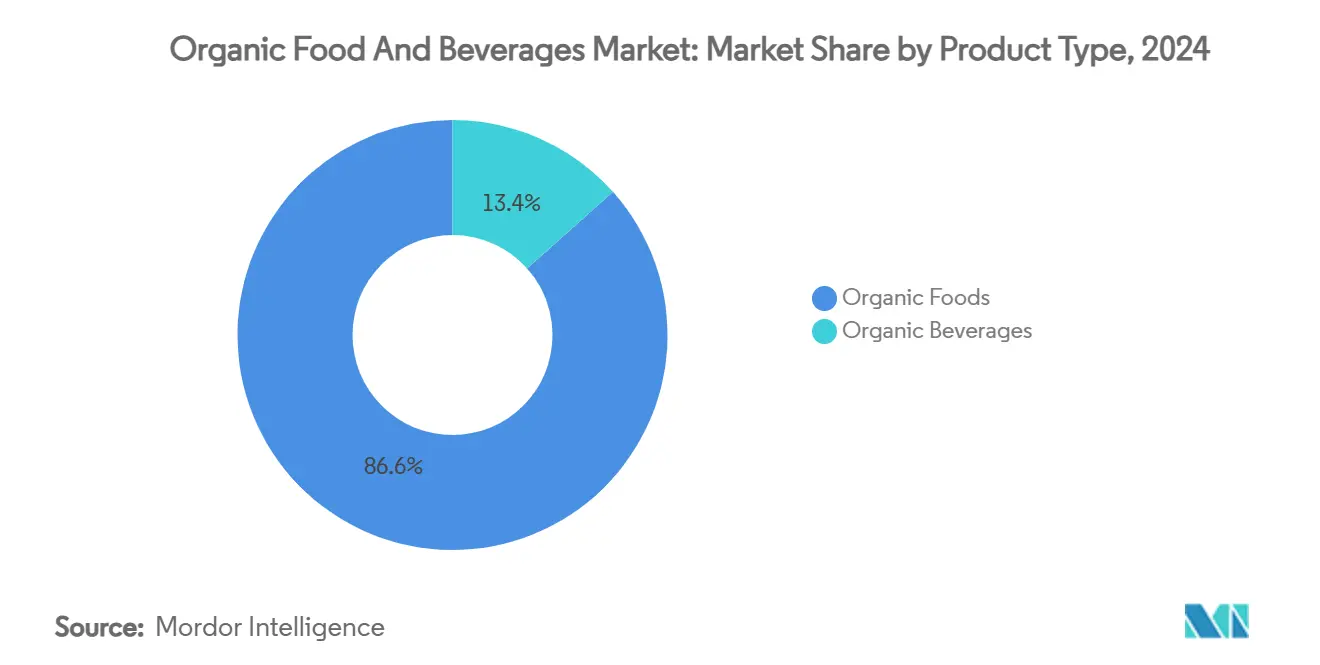
By Distribution Channel: Online Growth Reshapes Retail Landscape
Supermarkets and hypermarkets maintain a dominant 56.8% market share in 2024, with their business model adapting through dedicated organic sections, price-matching policies, and store-brand organic products. These retail formats implement comprehensive strategies to attract health-conscious consumers while managing operational costs. While these strategies reduce profit margins, they secure consistent sales volumes and customer loyalty. Club stores, particularly Costco, successfully target budget-conscious families with bulk organic offerings, providing cost advantages through economies of scale. Discount retailers Aldi and Trader Joe's demonstrate the highest unit growth through focused product selections, offering carefully curated organic options at competitive prices.
E-commerce channels show an 8.43% CAGR, driven by subscription-based ordering and improved delivery options. The digital transformation of organic food retail includes enhanced mobile applications, personalized shopping experiences, and efficient inventory management systems. While pure-play online retailers currently hold a small portion of the organic food and beverages market, this segment is expected to expand significantly as cold-chain delivery infrastructure develops and consumer comfort with online grocery shopping increases. Specialty retailers maintain their market position through knowledgeable staff and localized product offerings, often featuring unique and hard-to-find organic items.
By Form: Frozen Segment Capitalizes on Infrastructure Improvements
In 2024, fresh and chilled organic products dominated the market, making up 62.4% of total sales. Consumers view these minimally processed items, including organic leafy greens, dairy, and meat, as more nutritious due to their natural state and retention of vital nutrients. Responding to this demand, major retailers such as Whole Foods (U.S.), Carrefour Bio (Europe), and Nature’s Basket (India) have bolstered their micro-fulfillment cold rooms and invested in temperature-controlled logistics. This allows them to offer same-day or next-day delivery of perishable organic goods, enhancing product freshness, convenience, and consumer trust.
The frozen organic segment is on a rapid ascent, with projections indicating a 7.55% CAGR growth rate through 2030. This surge is bolstered by cold-chain infrastructure advancements in Asia-Pacific and North America, encompassing high-efficiency freezing technologies, automated cold storage, and temperature-monitored transportation. Retailers like Sprouts Farmers Market (U.S.) and Tesco are broadening their frozen organic selections, which now include vegetables, ready meals, and breakfast items. Furthermore, the integration of AI-driven demand forecasting is streamlining inventory management and curbing waste. On another front, canned organic products such as Field Day’s organic beans and Biona’s organic canned tomatoes are gaining traction among budget-conscious shoppers. Their appeal lies in affordability, shelf stability, and convenience, offering a year-round solution without sacrificing nutritional value.
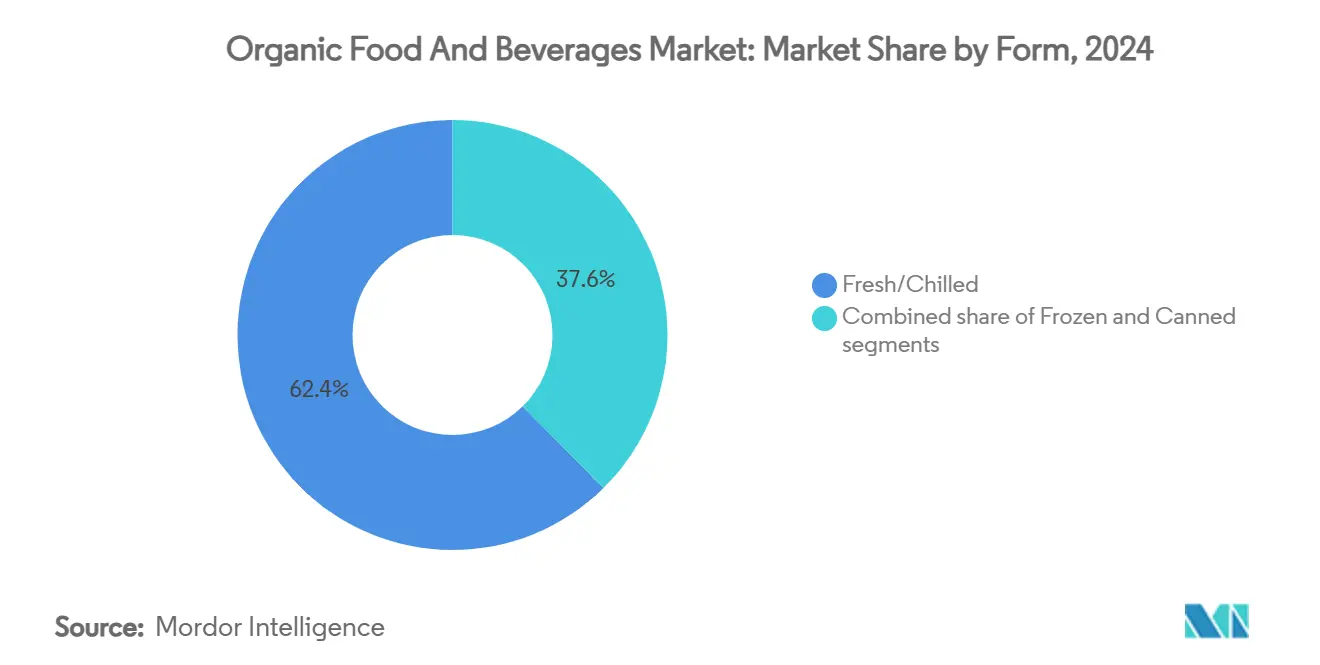
Note: Segment shares of all individual segments available upon report purchase
Geography Analysis
North America holds 43.1% market share in 2024, driven by mature regulatory frameworks and established consumer awareness. The region's dominance stems from widespread organic product adoption across retail channels and robust supply chain infrastructure. However, the region faces challenges from political uncertainty regarding organic program funding and new tariff policies affecting import flows. The USDA's comprehensive support programs, including the USD 300 million Organic Transition Initiative and enhanced enforcement mechanisms, strengthen market integrity and promote sustainable farming practices. Mexico contributes significantly with organic-certified area totaling 571,608 hectares (ha) in 2023, according to USDA data, reflecting the country's commitment to organic agriculture.
Asia-Pacific demonstrates strong growth at 7.46% CAGR through 2030, fueled by increasing disposable income, urban health concerns, and national farm-support programs like India's Paramparagat Krishi Vikas Yojana. The region's growth reflects changing consumer preferences and increasing health consciousness among urban populations. Major Chinese dairy companies Yili and Mengniu are expanding their organic product lines, increasing category awareness among middle-class consumers, and establishing distribution networks. Mobile commerce growth enables rural consumers to access certified organic products without extensive retail infrastructure, bridging the urban-rural divide in organic product accessibility.
Europe maintains its market position through systematic policy support, with the EU's Organic Action Plan aiming for 25% organic farming land by 2030. The region's commitment to sustainable agriculture drives continuous market development and innovation in organic farming practices. New EU organic regulations, effective January 2025, increase compliance requirements for small producers while enhancing consumer confidence in organic certification. South America demonstrates growth potential, with Peru and Brazil increasing farmer participation through agricultural biologicals adoption and sustainable farming initiatives. The Middle East and Africa present developing opportunities, as countries like Zimbabwe explore organic crop exports to meet global demand.
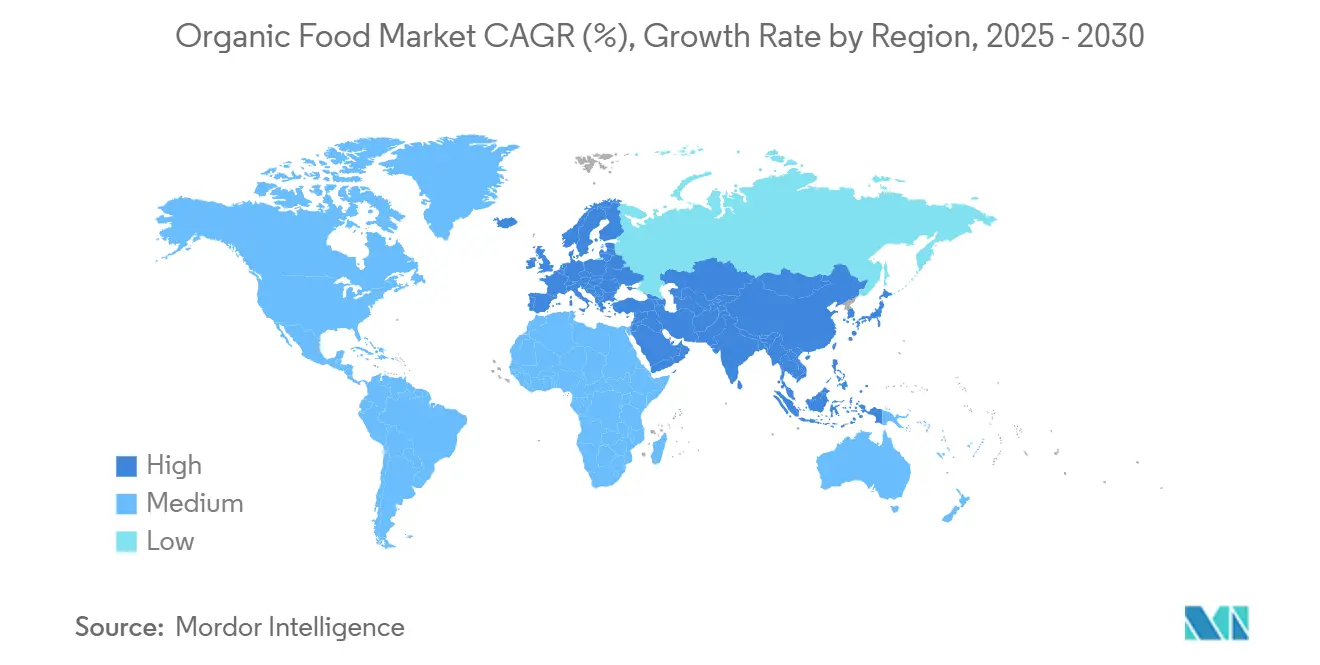
Competitive Landscape
The global organic food and beverage market remains fragmented, characterized by a mix of regional producers, local brands, and established multinational players vying for market share In this intensifying competition, major corporations are turning to strategic mergers and acquisitions, not just to broaden their product lines but also to strengthen distribution networks and harness economies of scale. Take Mars, for example: in March 2024, it made waves with a USD 35.9 billion acquisition of Kellanova, which amplified its foothold in the premium organic snack arena but also seamlessly integrated Kellanova’s robust distribution, diving headfirst into the burgeoning organic snack scene.
In this competitive arena, digital transformation stands out as a game-changer. Giants like Amazon are revolutionizing organic retail, harnessing cutting-edge tools like AI-driven inventory management, predictive analytics, and machine learning to refine fulfillment processes and tackle supply chain challenges. With global regulations tightening to combat organic fraud and bolster consumer trust, technologies like blockchain are gaining prominence for their ability to offer real-time traceability and certification checks. Beyond just boosting operational efficiency, these advancements play a pivotal role in enhancing transparency and fortifying brand credibility.
Independent organic producers and smaller farms are turning to direct-to-consumer (DTC) platforms and digital marketplaces, sidestepping traditional retail hurdles. Yet, they grapple with challenges like soaring certification costs and intricate regulatory demands. These pressures could push some towards cooperative formations or even exiting the market. To stay ahead, companies are weaving sustainability into their core ethos, embracing regenerative agriculture, curbing carbon footprints, and focusing on eco-friendly packaging.
Organic Food And Beverages Industry Leaders
-
Amy's Kitchen, Inc
-
General Mills Inc.
-
The Hain Celestial Group
-
Danone S.A
-
Conagra Brands, Inc.
- *Disclaimer: Major Players sorted in no particular order
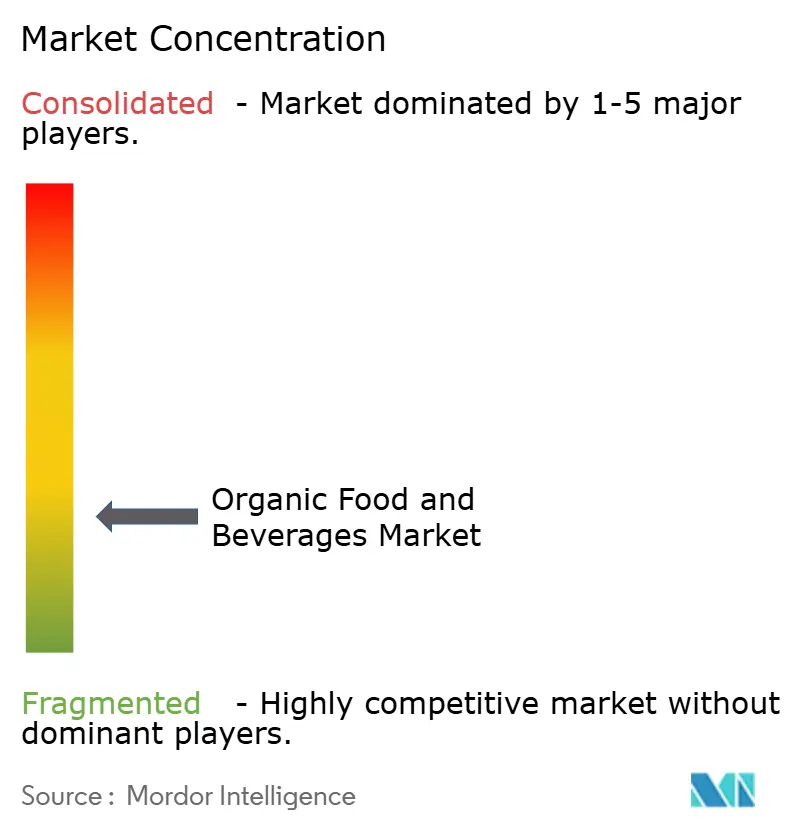
Recent Industry Developments
- May 2025: Yeo Valley Organic launched Protein Snack Pots, expanding its Greek Recipe yogurt range introduced in April. The new product line features two flavors - Mango and Strawberry, and Passionfruit - combining Greek yogurt with fruit in single-serve portions.
- May 2025: Hewitt Foods Pty Ltd. introduced a new brand, The Organic Meat Co., featuring USDA-certified organic, grass-fed, and finished beef products. The Organic Meat Co. product line includes organic ground beef, organic ground beef value packs, and organic sirloin, ribeye, tenderloin, and strip steaks.
- April 2025: Rude Health, UK natural food and drink company launched an organic dairy-free iced coffee range using its dairy-free milk products. The range comes in a chilled 750ml ready-to-serve format and features two varieties: Oat Latte Iced Coffee and Mocha Iced Coffee.
- January 2025: Natural Grocers introduced a new range of private-label organic soups. The product line includes six varieties that are certified organic, non-GMO, gluten-free, and dairy-free. The soups come in 14-ounce BPA-free pouches, designed to minimize environmental impact.
Research Methodology Framework and Report Scope
Market Definitions and Key Coverage
Our study defines the organic food and beverages market as retail and institutional sales of products that are certified to National Organic Program (or equivalent) standards and that cover the full value chain from crop or livestock origin to packaged end-product. These include fresh produce, meat, dairy, frozen and processed foods, plus organic juices, coffee, tea, and other drinks.
Scope exclusion: items such as "natural", "clean label", or uncertified plant-based foods and dietary supplements are not counted in our totals.
Segmentation Overview
- By Product Type
- Organic Foods
- Fruit and Vegetables
- Meat, Fish and Poultry
- Dairy Products
- Frozen and Processed Foods
- Other Foods
- Organic Beverages
- Fruit and Vegetable Juices
- Dairy-based
- Coffee
- Tea
- Other Beverages
- Organic Foods
- By Form
- Fresh/Chilled
- Canned
- Frozen
- By Distribution Channel
- Supermarkets/Hypermarkets
- Convenience Stores
- Specialty Stores
- Online Stores
- Other Channels
- By Geography
- North America
- United States
- Canada
- Mexico
- Rest of North America
- Europe
- United Kingdom
- Germany
- France
- Italy
- Spain
- Netherlands
- Poland
- Belgium
- Sweden
- Rest of Europe
- Asia-Pacific
- China
- India
- Japan
- Australia
- Indonesia
- South Korea
- Thailand
- Singapore
- Rest of Asia-Pacific
- South America
- Brazil
- Argentina
- Colombia
- Chile
- Peru
- Rest of South America
- Middle East and Africa
- South Africa
- Saudi Arabia
- United Arab Emirates
- Nigeria
- Egypt
- Morocco
- Turkey
- Rest of Middle East and Africa
- North America
Detailed Research Methodology and Data Validation
Primary Research
Mordor analysts interviewed certifying bodies, procurement heads at supermarket chains, organic farm cooperatives, and e-commerce specialists across North America, Europe, Asia-Pacific, and Latin America. These conversations validated conversion yields, average selling prices, and the speed at which online channels are capturing share, thereby filling gaps not visible in public datasets.
Desk Research
We began with agricultural census data and trade statistics from USDA, Eurostat, Comtrade, and FAO, which helped us size certified production and cross-border flows. Price movements were traced through consumer price indexes and the organic price dashboard of the USDA Market News. Insights on retail channel mix came from annual reports of leading grocery chains, while consumer behavior shifts were captured through scholarly articles indexed on PubMed and Scopus. Paid databases such as D&B Hoovers and Dow Jones Factiva supplied company revenue splits that anchor market share estimates. The sources listed illustrate the breadth we reviewed; many additional references supported data checks along the way.
We also screened trade-body releases from the Organic Trade Association, IFOAM, and national certification agencies to verify acreage trends, procurement contracts, and regulatory changes. These items alert us to sudden supply shocks or policy shifts that could distort market projections.
Market-Sizing & Forecasting
A top-down construct starts with certified output volumes and trade balances, which are then valued using weighted average retail prices. Results are corroborated through selective bottom-up roll-ups of supplier revenues and sampled ASP × volume checks for high-turn SKUs. Key variables like certified farmland hectares, per-capita organic spend, supermarket penetration rate, organic retail price index, and e-commerce share feed a multivariate regression that projects demand. Where supplier splits are missing, we bridge gaps with median gross margins observed in audited filings.
Data Validation & Update Cycle
Before sign-off, the model passes three internal reviews: variance screening, scenario stress tests, and peer audit. We refresh every twelve months, and we trigger interim updates if regulatory changes, crop failures, or major M&A events alter underlying assumptions.
Why Mordor's Organic Food and Beverages Baseline Earns Trust
Published estimates often diverge because firms pick different product mixes, pricing points, or update cadences, and because some widen scope to adjacent "natural" categories before inflating totals.
Key gap drivers include inclusion of uncertified foods, use of producer-gate prices instead of retail, aggressive ASP escalation, and sporadic refresh cycles that miss supply-chain disruptions.
Benchmark comparison
| Market Size | Anonymized source | Primary gap driver |
|---|---|---|
| USD 184.9 Bn (2025) | Mordor Intelligence | - |
| USD 258.9 Bn (2024) | Global Consultancy A | Counts uncertified natural foods and applies higher price inflation adjustments |
| USD 281.8 Bn (2024) | Research Publisher B | Adds dietary supplements and models demand on constant-currency growth without channel checks |
| USD 462.1 Bn (2024) | Regional Publisher C | Aggregates organic personal care plus pure top-down sizing with no farm-level validation |
The comparison shows that our disciplined scope selection, dual-track validation, and annual refresh give decision-makers a balanced, transparent baseline they can trace back to certified acreage, real prices, and repeatable steps.
Key Questions Answered in the Report
How big is the organic food and beverages market today?
It is valued at USD 184.9 billion in 2025 and is projected to reach USD 247.6 billion by 2030 at a 6.02% CAGR.
Which region dominates sales?
North America leads with 43.1% of global revenue, supported by mature regulation and high consumer awareness.
What product segment is growing fastest?
Organic beverages show the highest momentum, forecast to expand at a 7.26% CAGR through 2030.
What role does e-commerce play in future growth?
Online channels are the fastest-growing distribution route, expected to rise at an 8.43% CAGR thanks to last-mile cold-chain upgrades and consumer appetite for convenient home delivery.
Page last updated on:
